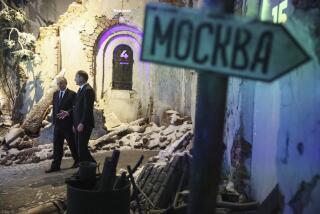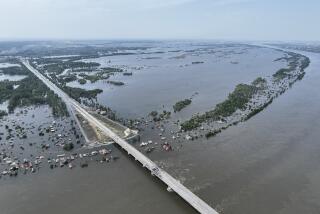Cloud Drifts Back Toward Soviets
An invisible plume of radioactive material emanating from the damaged Chernobyl nuclear plant abruptly reversed its course Tuesday and drifted slowly south through the Soviet Union.
Meteorologists monitoring the mass of vapors generated by the nuclear accident near the Ukrainian city of Kiev said the plume had been moving over Sweden toward the polar region when a low-pressure front checked its advance and steered it back toward the Soviet Union.
U.S. officials said it appears that the vapors are dissipating and that they represent a rapidly declining health risk. Danger to the United States is insignificant, they said.
National Weather Service scientists estimated that the cloud was moving at 15 to 20 miles an hour south of Kiev toward the Black Sea. They said the weather front should continue to drive the plume in a southeasterly direction through Thursday.
The development extended by at least two days the time that experts had estimated it will take traces of radioactivity to reach the United States, further reducing health risks posed to Americans by the Soviet disaster.
“To get to the United States, the cloud now is going to have to go the long way around,” said Lester Machta, director of the National Oceanographic and Atmospheric Administration’s air resources laboratory in Silver Spring, Md.
A spokesman for the California Department of Health said the contaminants from the nuclear accident are still expected to reach the Western United States first.
“Our best information from our staff,” said William Ihle, chief spokesman for department, “is that the cloud will arrive on the West Coast in approximately seven days. We have accelerated our testing at stations at a dozen or more sites in California, and that will allow us to know quite rapidly if there is any exposure problem.”
Stations on Alert
A national network of 67 radiation-monitoring stations also was placed on full alert, and the Reagan Administration appointed a task force of experts from several agencies, including the Environmental Protection Agency, the Air Force and the CIA.
Reports from Scandinavia indicated that the average level of radiation detected there was 3 millirems. Most people are routinely exposed to 200 millirems over a year’s period. A common dental X-ray emits about 5 millirems.
James C. Warf, an expert in nuclear energy at the University of Southern California, said that initially the cloud probably “would be deadly” to anyone within 15 miles of the accident. However, he said, as the cloud expands, its lethal properties fade. By the time the contaminants reach the United States, Warf said, the health risk will be “none that is measurable.”
Officials and scientists in some of the countries over which the cloud moved Sunday and Monday--Sweden and Finland--also reassured their citizens that the radiation was not strong enough to be harmful. But Polish authorities acknowledged Tuesday that there is a potential health risk and said they will issue medication to children, restrict the sale of milk and recommend the washing of all vegetables.
There were no reports from the Soviet Union about the levels or effects of radiation in the plume.
Long-Term Uncertainties
Experts were less certain about potential for longer-term health effects from radiation borne by the cloud, and said that although the hazards do not appear great, the situation merits close scrutiny.
For example, an increased rate of leukemia in residents of Washington County, Utah, has been linked to fallout from atmospheric nuclear weapons tests at the Nevada test site in the 1950s. Residents of Washington County, which is in the southwest corner of Utah, received about 1.1 rems (1,100 millirems) from the tests, and the leukemia was detected several years after exposure.
Carl Feldbaum, a co-author of a Pentagon-funded report on the effects of nuclear winter, said that “based on what we think we know, one would tend to agree with EPA’s assessment that there’s no danger to the United States. But we don’t know the long-term effects of low-level radiation.”
In an interview, Feldbaum said that the lack of information from the Soviet authorities leaves unanswered several crucial questions: “Do we know if it’s continuing? We don’t know the state of the accident. If it continues to burn, there could be millions of curies of radioactive materials released into the atmosphere. . . .
“It’s not only a question of wind direction but just how high in the atmosphere (the cloud) rises. If it catches air currents, then it could carry a longer distance.”
Two Deaths Announced
The Soviet Union has announced only two deaths in the disaster so far, a toll that Western experts believe is suspiciously low. The Soviets have not released any radiation figures, leaving experts to analyze readings taken in Scandinavia, at a point about 700 miles from the source of the radiation.
The U.S. monitoring network, called the Environmental Radiation Ambient Monitoring Systems, measures air, drinking water, surface water and milk, usually testing them twice a week. Now, said John Kasper, a spokesman for the EPA, the checks will be made daily. There are two stations in Los Angeles.
U.S. scientists have been left with little hard evidence about the cloud’s chemical composition. However, analysis of the few known facts about the vapors and the body of knowledge about Soviet nuclear systems have led them to conclude that the cloud contains a variety of radioactive elements.
Steam, Dust, Gases
According to USC’s Warf, who served on the Manhattan Project, which developed the first atomic bomb, the extremely high temperatures generated by the explosive accident most likely created an aerosol of steam, dust and gases.
He calculated that the aerosol probably contains a mixture of as many as 400 radioactive fission products, including iodine 131, strontium 90, cesium, krypton and some plutonium isotopes.
These elements vary in their toxic properties. Some, such as plutonium, are regarded as highly dangerous to humans under certain conditions; others decay quickly and present lesser hazards. The contents of the mixture, experts said, most likely are dispersing at such a rapid pace that their potential for immediate harm has been or soon will be eliminated.
Out of Control
That the reactor fire in Kiev apparently continued to burn out of control Tuesday was of concern to some scientists. Experts familiar with the construction of the reactor, however, said they believe that most of the radiation was emitted in the first hours of the disaster, and that later smoke from the plant would contain far fewer toxic substances.
Said Ihle of the state Health Department: “Our scientists, and there are a couple who studied this type of facility, believe that because of what we are seeing now in Europe and Scandinavia, the levels in California and the West will be barely detectable. Very honestly, we don’t expect that will change.
“If there is a change,” he said, “we will move very rapidly on it.”
Ihle declined to say what contingency plans would take effect should a drastic change in the situation develop.
Times staff writers Thomas H. Maugh II in Los Angeles and Lee May, Ronald J. Ostrow and Robert C. Toth in Washington also contributed to this story.
More to Read
Sign up for Essential California
The most important California stories and recommendations in your inbox every morning.
You may occasionally receive promotional content from the Los Angeles Times.











